166 - Overview of Primary Mediastinal Tumors and Cysts
Editors: Shields, Thomas W.; LoCicero, Joseph; Ponn, Ronald B.; Rusch, Valerie W.
Title: General Thoracic Surgery, 6th Edition
Copyright 2005 Lippincott Williams & Wilkins
> Table of Contents > Volume II > The Mediastinum > Section XXX - Mediastinal Cysts > Chapter 197 - Mesothelial and Other Less Common Cysts of the Mediastinum
function show_scrollbar() {}
Chapter 197
Mesothelial and Other Less Common Cysts of the Mediastinum
Thomas W. Shields
In addition to the previously described enterogenous and neuroenteric cysts (Chapters 194, 195, 196), other mediastinal cysts include mesothelial (pleural, pericardial) thoracic duct, thymic, parathyroid, and hydatid cysts. Cystic lesions arising in the mediastinum are most commonly located in the anterior and visceral compartments. Pathologic features of these cysts, as expected, are related to their tissue of origin. Despite their rarity and the paucity of symptoms associated with their presence in most cases, a clear knowledge of etiology, pathology, and clinical significance of each variety is necessary.
MESOTHELIAL CYSTS
Mesothelial cysts comprise a variety of cysts that have been reported as pleuropericardial cysts, pleural cysts, lymphogenous cysts, and simple mesothelial cysts of the mediastinum. These are essentially unilocular cysts filled with clear or slightly yellowish thin fluid. Most often they are incidental radiologic findings. They may be classified as one of two types: (a) pleuropericardial cysts and (b) other mesothelial (pleural) cysts.
Pleuropericardial Cysts
Pickhardt (1934) is responsible for the first surgical resection of a pleuropericardial cyst from the mediastinum. According to the review by Lillie and associates (1950), cystic lesions surrounding the heart had been described as early as 1854. One of the more intriguing aspects of pericardial cysts is their origin. Lambert (1940) was the first to discuss the cause of pericardial cysts. He stated that the pericardium arises from a series of disconnected lacunae early in embryonic life. These lacunae merge as the embryo enlarges to form the pericardial coelom. Failure of one of these lacunae to merge results in subsequent cyst formation.
Further evaluation of the development of the pericardium revealed the presence of ventral and dorsal parietal recesses during embryonic development (Fig. 197-1). The ventral parietal recess is a diverticular structure where the majority of pericardial cysts are located. Lillie and associates (1950) maintained that pericardial cysts formed secondary to persistence of the ventral parietal recess. Constriction of the diverticular neck of the recess or complete obliteration of the neck results in a mesothelial-lined cyst. This is believed to explain the frequency of pericardial cysts located at the cardiophrenic angle. Of 37 cases of mesothelial cysts reviewed by Lillie and colleagues (1950), 17 were located at the cardiophrenic angle. A significant prevalence of these cysts occurs in the right cardiophrenic angle. In the series of 18 pleuropericardial cysts reported by Kutlay and associates (2001), 11 cysts were located in the right cardiophrenic angle (61%), four in the left angle (22%), and three in other locations (16%). The latter three cysts were in the right paratracheal area immediately above the heart. Cysts located outside this area are believed to occur secondary to complete obliteration of the diverticular neck and subsequent translocation during embryonic growth (Table 197-1).
Both Lambert (1940) and Lillie and colleagues (1950) reported that, pathologically, these cysts are lined with mesothelium and contain a clear waterlike fluid. Hence, these lesions were initially named spring water cysts. Le Roux (1959) noted that most commonly, these cysts are unilocular. Le Roux and associates (1984) recorded that 5% of pericardial cysts communicate with the pericardium through definable tubelike structures. When communication of the cyst with the pericardium persists, the lesion may be considered a pericardial diverticulum (Fig. 197-2).
Mesothelial cysts are estimated to occur in approximately 1 of every 100,000 persons. Ochsner and Ochsner (1966), in reporting 42 cases of various congenital cysts of the mediastinum, noted that 14 (33%) were mesothelial in type; of these, 11 were pleuropericardial and 3 were
P.2853
pleural in location. Stoller and associates (1986) reported likewise that the right cardiophrenic angle was most often involved; 50% to 70% of these cysts were located in the right cardiophrenic angle (Fig. 197-3), 20% to 30% in the left (Fig. 197-4), and the remainder elsewhere in the visceral compartment. In light of their prevalence at the cardiophrenic angle, appreciation of the anatomy of the anterior cardiophrenic angle is important in making an accurate diagnosis.
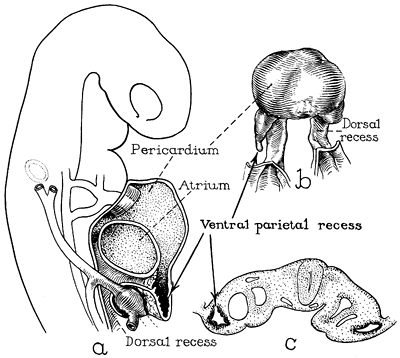 |
Fig. 197-1. A. Parasagittal section of rabbit embryo, 9 days old. The ventral parietal recess pockets into the septum transversum are illustrated. B. The ventral surface of a cut of the pericardial coelom of a 20-somite human embryo illustrating the diverticulumlike appearance of the ventral parietal recesses. C. Transverse section of a 10-somite rabbit embryo, giving another representation of the spatial relationships of the parietal recess. From Lillie WI, McDonald JR, Clagett OT: Pericardial celomic cysts and pericardial diverticula. A concept of etiology and report of cases. J Thorac Surg 20:494, 1950. With permission. |
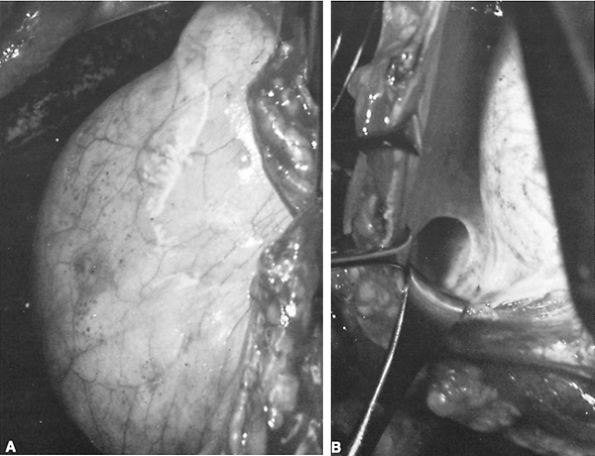 |
Fig. 197-2. Pleuropericardial cyst with persistent communication to the pericardial sac, hence a true pericardial diverticulum. A. Diverticulum as seen at operation. B. Persistent communication between diverticulum and pericardial sac is well demonstrated. |
Table 197-1. Lesions that May Result When Parietal Recess Persists | ||||||||||||||
|---|---|---|---|---|---|---|---|---|---|---|---|---|---|---|
| ||||||||||||||
The anterior cardiophrenic angle, as defined by me and my associates (1962), is the space bounded by the pericardium medially, the chest wall anteriorly, the pleura laterally, the phrenic nerve posteriorly, and the diaphragm inferiorly. A multiplicity of lesions can be noted in this area; accurate diagnosis is essential. The most important lesion with regard to differential diagnosis is a foramen of Morgagni hernia, which can contain visceral structures and be associated with serious consequences (see Chapter 52). Other important lesions include ventricular aneurysms, mediastinal tumors, enlarged pericardial fat pad, diaphragmatic
P.2854
tumors, diaphragmatic eventration, and pulmonic or pleural processes.
 |
Fig. 197-3. A, B. Posteroanterior and oblique radiographs of the chest reveal the presence of a pleuropericardial cyst in the right anterior cardiophrenic angle. |
The few pericardial cysts that occur outside of the anterior cardiophrenic angle (8% to 16%) are usually superior to the heart but again seem to be more often located on the right side rather than on the left (Fig. 197-5). A frequent site is between the superior vena cava and the azygos vein adjacent to the wall of the trachea. Stoller and associates (1986) were among the first investigators to note that other pericardial cysts also could be located in association with either hilar area or in the neighborhood of the aortic arch. Any of these cysts may have an open communication into the pericardium. A solid tissue pedicle may run to or toward the pericardium or the cyst may be free of any such attachment to the pericardium.
Le Roux and colleagues (1984) stated that only 20% of pericardial cysts present symptomatically, usually with dyspnea or chest wall discomfort. It is an interesting observation that symptoms rarely dissipate with excision unless the cyst was of significant size. An unusual complication was reported by Borges and associates (1997). An acute hemorrhage into the cyst occurred with resulting tamponade with right-sided heart failure. This was corrected with resection of the cyst by a video-assisted thoracic surgical technique (VATS). Partial erosion of the right ventricle and partial erosion of the superior vena cava have been reported by Chopra (1991) and Mastroroberto (1996)1 and their colleagues, respectively.
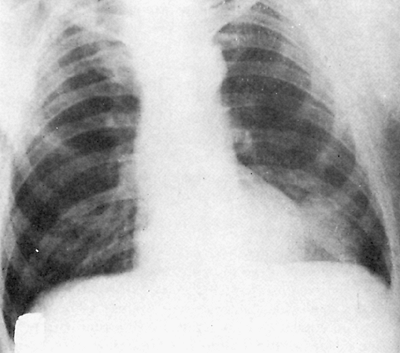 |
Fig. 197-4. Posteroanterior view of chest radiograph reveals the presence of a left-sided pleuropericardial cyst. |
Radiography of the chest, echocardiography, and chest computed tomographic (CT) scanning are the most commonly used modalities for diagnosis of pericardial cyst. On infrequent occasion, contrast studies of the gastrointestinal tract are necessary to rule out a foramen of Morgagni hernia, but CT examination often reveals bowel in the mass when the lesion is a foramen of Morgagni hernia (Fig. 197-6). Jost (1978) and Pugatch (1978) and their associates, as well as Kaimal (1982), have described the essential CT features of the pericardial cysts (Fig. 197-7). These include
P.2855
low attenuation values characteristic of a waterlike liquid filled cyst, no enhancement with contrast material, and a thin to almost absent cystic capsule.
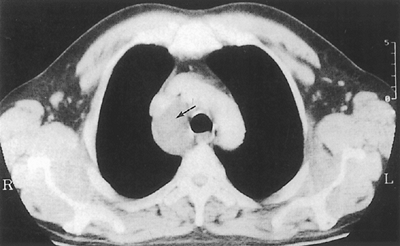 |
Fig. 197-5. CT scan showing a pericardial cyst (arrrow) in the right paratracheal area. From Kutlay H, et al: Atypically located pericardial cysts. Ann Thorac Surg 72:2137, 2001. With permission. |
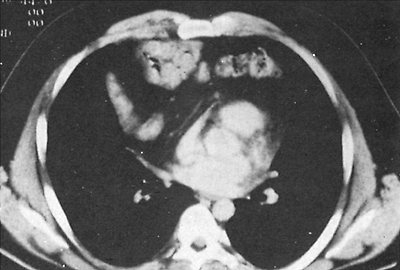 |
Fig. 197-6. CT scan of the chest reveals the presence of a large bowel anterior to the heart arising through a foramen of Morgagni hernia. Courtesy of D. Aberle, M.D., University of California, Los Angeles, UCLA School of Medicine. |
Surgical resection has been the preferred therapy (Fig. 197-8), either by an open procedure or by VATS. Very large cysts, as reported by Satur and associates (1996), can readily be successfully resected by a VATS procedure. With confirmation of the cystic nature of the lesion by CT scan and fine-needle aspiration (FNA) of clear watery fluid further confirming the diagnosis, Stoller and colleagues (1986) suggested that simple aspiration is an acceptable treatment because none of these cysts have any malignant potential. The aspiration of an unrecognized primary or secondary hydatid cyst of the mediastinum in this area is highly unlikely except in individuals from or living in areas of high epidemicity of Echinococcus granulosus infestations. In such situations, specific serologic tests (see Chapter 91) for the disease may be conducted. Of course, if doubts still persist, then excision rather than aspiration should be performed.
 |
Fig. 197-7. CT scan of the chest reveals a typical pleuropericardial cyst. The lesion is nonenhancing (white square), contiguous with the right side of the pericardium. The attenuation value was characteristic of a cystic lesion. Adapted from Kaimal KP: Computed tomography in the diagnosis of pericardial cyst. Am Heart J 103:565, 1982. |
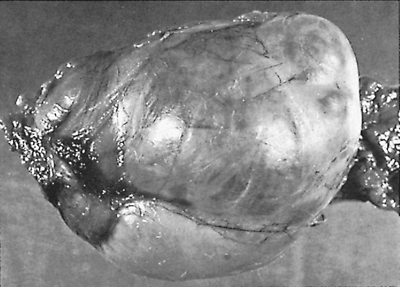 |
Fig. 197-8. Photograph of a surgically excised mesothelial (pleuropericardial) cyst of the mediastinum. |
Simple Mesothelial (Pleural) Cysts
Unilocular mesothelial cysts occurring primarily in the anterior compartment of the mediastinum frequently have been referred to as lymphangiomatous or unilocular cystic hygromas. These designations are most likely inappropriate because the histologic structures of the wall and the internal structure of the cyst fail to reveal the features of a true lymphangioma (isolated mediastinal cystic hygroma; see Chapter 192) and instead reveal only a single layer of flattened endothelial cells with an underlying connective tissue stroma without interlacing bands within the cystic structures.
These lesions are most often asymptomatic and are discovered only on incidental radiography of the chest (Fig. 197-9). In retrospect, I had misclassified the lesion shown in Fig. 197-9 as a unilocular cystic hygroma in the early editions of General Thoracic Surgery. It also is likely that most of the 18 so-called lymphangiomas of the mediastinum collected by Childress and associates (1956) were either unilocular mesothelial (pleural) or pleuropericardial cysts. Jamplis and colleagues (1963) reported a mesothelial cyst in the anterior compartment of the mediastinum as well as one in a costovertebral sulcus. Klein (1978) also reported a mesothelial cyst located in a paravertebral sulcus. In the patient with the cyst in the paravertebral sulcus reported by Jamplis and colleagues (1963), vertebral body erosion was noted.
Evaluation of these mesothelial cysts, after initial identification of a mediastinal mass by radiology, is by ultrasonography
P.2856
or CT examination. The cystic nature of the lesion is readily identified by either of these two studies.
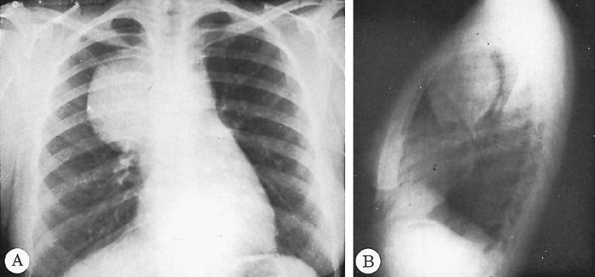 |
Fig. 197-9. A, B. Posteroanterior and lateral radiographs of a young woman with a large unilocular mesothelial cyst of the mediastinum. The trachea is displaced posteriorly. |
When the lesion is small and asymptomatic, periodic observation is a reasonable course of action. When the lesion is large or thought to be the cause of symptoms, surgical excision is recommended via the most appropriate thoracic approach. Surgical excision is definitely diagnostic and curative.
THYMIC CYSTS
Thymic cysts of the mediastinum are uncommon. Bieger and McAdams (1966) reported that they constitute only 1% of mediastinal masses. Cohen and colleagues (1991), however, reported an incidence of 4.8% in a series of 230 patients from Walter Reed Army Hospital, most of whom can be assumed to have been adults. Likewise, Hirano and associates (1997a) reported an incidence of 4.9% in 242 mediastinal masses in a Japanese series. In children, the incidence of thymic cysts was less than 1% of 108 mediastinal masses reported in Japanese children by Akashi and associates (1995). In Hirano and associates' (1997a) series, thymic cysts accounted for 14.6% of the 82 cystic lesions identified in their 242 patients, whereas Abell (1956) only identified thymic cysts in 2 of 36 cystic lesions (5%).
Thymic cysts are inevitably found along the developmental tract of the thymus and hence can be located in the neck or in the anterior compartment of the mediastinum, as noted by le Roux and associates (1984), Krech and Storey (1954), and Bieger and McAdams (1966). The cysts are most often mediastinal in location, and according to the review by Fahmy (1974), more than half of the cervical thymic cysts extended into the mediastinum.
Typically, the thymic cyst is unilocular and has a smooth fibrous capsule lined by epithelium that may be composed of cuboidal; columnar, with or without cilia; transitional; or squamous cells. Cholesterol clefts and granulomas with foreign body cells are commonly found within the cyst wall, and these findings according to Wick (1990) are unusual in other cystic lesions in the mediastinum. Thymic tissue within the wall is thought to be necessary to establish the diagnosis of a thymic cyst. The thymic tissue varies in amount but typically shows corticomedullary differentiation and Hassall's corpuscles, both solid and cystic. Wick (1990) noted that Hassall's corpuscles can be found in roughly 50% of the thymic cysts. Guba and colleagues (1978) described the finding of either thyroid or parathyroid tissue in many of the cervical thymic cysts.
Wick (1990) has described a subtype of the thymic cysts. This is the so-called proliferating variant. In these cysts there are narrow and often interconnecting tongues of squamous epithelium that project irregularly into the fibrous cyst wall, simulating an invasive carcinoma. However, the cells are cytologically bland and amitotic; the borders of the penetrating strands of squamous cells are essentially even, which would be uncharacteristic of a malignancy. All in all, this subtype (proliferating variant) behaves clinically, as do the more common nonproliferating cell types of thymic cysts. The fluid in the cysts is usually clear but may be turbid or sanguinous. In addition to the unilocular cysts, multilocular thymic cysts also may occur, but less commonly so. Suster and Rosai (1991) reported a series of 18 patients with multilocular thymic cysts. These cysts appear as soft, rubbery masses in the anterior mediastinal compartment, and on cut section multiple cavities (multilocular) are filled with gray-brown or dark bloody fluid. The walls are thick and fibrous, and multiple septa and areas of solid tissue are
P.2857
present. The microscopic features, however, are not dissimilar to those found in the unilocular cysts.
The cause of thymic cysts originally was somewhat controversial. Bieger and McAdams (1966) noted that Dubois in the mid-19th century (1850) reported cystic lesions of the thymus (Dubois' abscesses) in postmortem examinations of children who died secondary to congenital syphilis. At present, most believe that the unilocular thymic cysts are either congenital or originate from cystic dilation of bronchial pouch remnants. The congenital theory is believed by most. On the other hand, the multiloculated cysts are acquired lesions; infection, immune-mediated pathogenesis, trauma, and neoplasia have been noted to be the underlying associated causes of the multiloculated cysts by Suster and Rosai (1991), Kornstein (1995), and Jaramillo and colleagues (1989). The multilocular cysts are an acquired reactive process; often an inflammatory reaction is present, as are multiple adhesions to adjacent structures. The cysts arise in the thymic gland in contrast to the extrathymic location of the congenital unilocular cysts. Their association with neoplasia has been noted by Suster and Rosai (1991), especially seen in patients with nodular sclerosing Hodgkin's disease and mediastinal seminomas. A few are seen in patients with acquired immunodeficiency syndrome (AIDS), as noted by Avila and co-workers (1996) (an incidence of 0.9%). Others are found to be associated with myasthenia gravis [four of eight patients described by Choi and associates (2001) presented with this association]. A small number of cases have been associated with Sj gren's syndrome, as noted in the patient reported by Kondo and colleagues (2001) and in two of the patients recorded by Suster and Rosai (1991). Of particular interest is the occurrence of incidental thymic epithelial tumor (thymoma) and thymic carcinoma in the wall of the multiloculated thymic cyst.
The presence of thymoma is an unusual finding in a true unilocular (congenital) thymic cyst. This occurrence must be differentiated from a cystic thymoma. Eight cases have been described in the Japanese literature. The most recent three cases have been reported by Noriyuki (1995), Kurihara (1995), and Udaka (1995) and their associates. All of the latter three patients were young adults, and the thymoma made up only a small portion of the thymic cyst. Yamashita and colleagues (1996) and Babu and Nirmala (1994) have also described thymic carcinomas that arose in congenital thymic cysts. It would appear that the appropriate classification of such lesions as thymic cysts is to some extent suspect.
Graeber and associates (1984) reported 39 true thymic cysts in a total of 46 cystic lesions associated with the thymus. With modern diagnostic techniques, the seven patients whose lesions were not true cysts undoubtedly could have had a correct diagnosis established before surgical excision. These investigators did not identify the location of the true cysts per se, but of the total of 46 lesions, 30 were located in the anterior mediastinal compartment, 9 were cervicomediastinal, and 7 were located only in the neck.
The symptoms of thymic cysts vary greatly with respect to their location. The cervical thymic cysts frequently present with a lateral neck mass but rarely with significant symptoms unless an acute change in size occurs secondary to hemorrhage. However, Graeber and colleagues (1984) reported that two of the seven cysts located in the neck resulted in pain in one patient and vocal cord paralysis in the other; both were benign lesions. Mediastinal thymic cysts confined to the mediastinum are rarely symptomatic. However, dyspnea, cough, and chest pain have been described in the reviews of Allee and associates (1973) and Bieger and McAdams (1966), as well as in the review of Fahmy (1974). Allee and colleagues (1973) reported a thymic cyst associated with pericarditis and cardiac tamponade. Graeber and colleagues (1984) also reported four instances of dysphagia associated with large thymic cysts. Other unusual symptoms or signs infrequently associated with thymic cysts have been the occurrence of Horner's syndrome reported by Fraile and associates (1992) and the occurrence of intermittent brachiocephalic vein obstruction recorded by Miller and associates (2000). G n l and colleagues (1996) recorded five patients with varying degrees of dyspnea as the result of very large thymic cysts that filled a significant portion of the hemithorax in which the lesions were located. The largest cyst measured 30 25 cm and the smallest (two of the five) 8 5 cm. Monnier and co-workers (2000) also described a large ectopic paracardial thymic cyst that on radiographic and echocardiographic studies of the chest showed compression of the right heart chambers, although the patient was asymptomatic at the time of its discovery.
Cervical thymic cysts are most commonly discovered in the first and second decades of life, whereas mediastinal thymic cysts are noted in the third to the sixth decades, however, in Graeber and associates' series (1984), only one patient was over 40 years of age. This difference in the time of discovery of cervical versus mediastinal thymic cysts most likely represents the fact that cervical thymic cysts are easily noted on physical examination and mediastinal thymic cysts are discovered most often only as an incidental finding on routine radiography of the chest (Fig. 197-10).
Thymic cysts of the mediastinum in children are mostly initially misdiagnosed according to Hendrickson and associates (1998). These investigators reported their experience with seven children with mediastinal cysts, in two of whom the cyst extended from the cervical region into the mediastinum. The cysts ranged in size from 3 to 22 cm and all cysts to a greater or lesser degree compressed or distorted adjacent structures, and 60% of the mediastinal cysts and both cervicomediastinal cysts were symptomatic. An incorrect preoperative diagnosis was made in most but on resection the true nature of the lesion was readily resolved. The macroscopic and microscopic features were as described previously.
Although Young and associates (1973) stressed the value of ultrasonography in the evaluation of this lesion, most
P.2858
now believe CT of the chest and neck should be used to determine the extent and the cystic nature of the lesion. Gouliamos and colleagues (1982) described the features of thymic cysts (Fig. 197-11). These should include a homogeneous mass of low attenuation value (i.e., low Hounsfield number) and an indistinct surrounding capsule. The CT findings of the acquired multiloculated cysts have been presented in detail by Choi and associates (2001). Briefly, the walls are thick and the lesion is multicystic with soft tissue attenuation within the lesions. Furthermore, the lesion is always associated with or is a part of the thymic gland. A cystic thymoma is nonhomogeneous in nature, and a solid tissue mass or masses may be identified arising from the cystic wall. It is essential that a cystic epithelial thymic tumor (thymoma) not be confused with a congenital thymic cyst. However, it should be noted that Leong and Brown (1984) reported the rare development of a squamous cell carcinoma in a preexisting thymic cyst. Thus, it cannot be assumed that a thymic cyst is always a benign lesion.
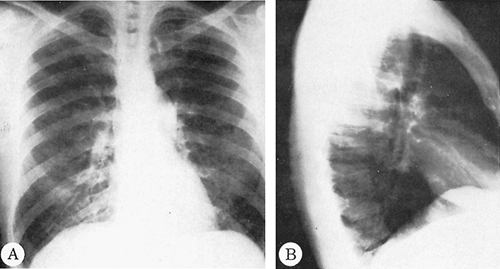 |
Fig. 197-10. A, B. Posteroanterior and lateral radiographs of the chest in a young adult man with a mass seen anterior to the left hilar area. A vague, ill-defined mass is seen anterior to superior border of the heart on the lateral view. Excision proved the lesion to be a thymic cyst. |
The treatment of unilocular congenital thymic cysts is controversial. Some believe that all should be removed to definitely diagnose the lesion. Others, such as Rastegar and associates (1980), believe that if the diagnosis is strongly suggested by the location of the lesion and the presence of characteristic CT findings, nothing need be done. If the possibility of an echinococcal cyst can be ruled out, percutaneous FNA under CT guidance may be attempted for cure. If any doubt exists as to the true nature of the lesion, however, especially if a cystic epithelial thymic tumor cannot be ruled out, surgical excision is indicated to establish a final pathologic diagnosis. All multilocular cysts should be removed by thymectomy so that any neoplastic change may be identified. Surgical excision either by the open method via a median sternotomy, a standard or one of the many variations, or by a video-assisted surgical technique as described in Chapter 164 should be performed. Excision, of course, is curative.
PARATHYROID CYSTS
A parathyroid gland is not normally an intrathoracic structure. However, supernumerary parathyroid glands may be present in 6% of individuals; 94% of these glands are a single additional gland (the fifth gland), but 6% of these individuals have two or more supernumerary glands. Almost all of these supernumerary glands are found in the anterior mediastinal compartment and are associated with the thymus, but a small number of these glands are located in the visceral compartment associated with the great vessels as they leave the pericardium. However, a lower (parathyroid III) or an upper (parathyroid IV) gland may be displaced from the neck and descend into the mediastinum. The inferior or parathyroid gland III most often passes caudally into the pretracheal space between the trachea dorsally and superior portion of the manubrium of the sternum and innominate vessels ventrally to enter the visceral compartment at and just below the thoracic inlet to lie paratracheally in the anterosuperior portion of the mediastinum. At times, with a cystic enlargement of the gland, it may even override the innominate vessels and protrude into the true anterior compartment of the mediastinum. A superior or parathyroid gland IV will descend into the visceral compartment laterally behind the recurrent nerve and the trachea, at times as far posteriorly as the level of the esophagus. Frequently when this occurs, as noted by Nathaniels and associates (1970), the displaced gland is attached by a large vascular pedicle that ascends to the inferior thyroid vessel in the neck.
A small number of these glands become true thin-walled cysts, while others represent a cystic adenoma. Globally, both varieties are included in the category of parathyroid cysts of the mediastinum. Likewise, parathyroid cysts of the neck that protrude partially (cervical mediastinal parathyroid cysts) or intermittently wholly into the mediastinum also are considered in the global category of mediastinal parathyroid cysts. Actually, parathyroid cysts in
P.2859
either the neck or mediastinum are uncommon. The incidence has been stated to vary from 0.08%, as reported by Welti and G rard-Marchant (1956), to 0.9%, as recorded by Molinari and associates (1996), to 2.8%, as identified by Gilmour (1939) in 428 postmortem examinations. The mediastinal cysts occur much less frequently than those in the neck. The typical parathyroid cyst is thin walled, unilocular, and contains a clear, watery, colorless fluid, although the fluid may be opalescent, gray, or serosanguinous. The fluid when analyzed has a significant level of parathyroid hormone (PTH) present, which is greater than the serum level of the hormone in the patient. The inner wall generally is lined by a single layer of cuboidal or low columnar cells; infrequently, the cellular layer may be absent. In all cases, however, islets of normal parathyroid cells are found within the fibrous wall of the cyst. Infrequently, a macroscopic mass of parathyroid tissue of varying size, as described by Noble and Borg (1936), Margolis and colleagues (1975), and Simkin (1976), among others, is present and attached to the wall of the cyst. Fatty tissue, thymic tissue, and calcifications may be identified sometimes within the wall as well. Grossly, the cysts may vary from 0.5 to 12.0 cm or more in largest diameter. In addition to these typical cysts, a second variety may have a thicker layer of parathyroid cells
P.2860
on the inner surfaces, but in all cases a well-defined macroscopic cyst ranging from 1 to 5 cm or larger in size is present. This second variety is often referred to as a cystic parathyroid adenoma, but just as often they are reported simply as parathyroid cysts. Rarely, a cyst is multiloculated, as reported by Kuriyama and associates (1986).
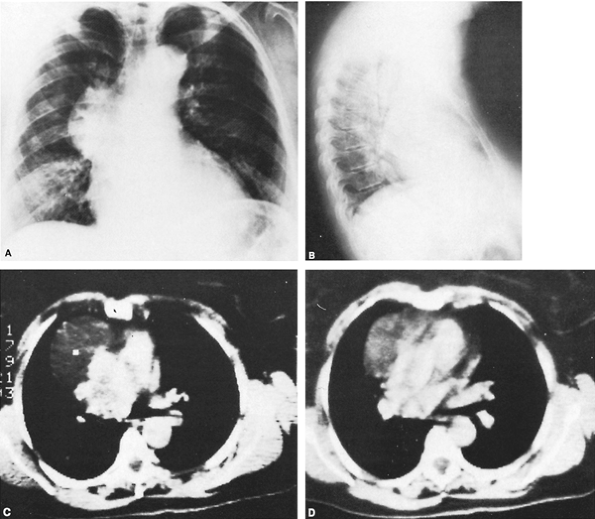 |
Fig. 197-11. A, B. Posteroanterior and lateral chest radiographs reveal an anterior mediastinal mass. C, D. CT scans show a water density mass in the anterior compartment of the mediastinum. The mass proved to be a thymic cyst on excision and histologic examination of the resected specimen. From Gouliamos A, et al: Thymic cyst case report. J Comput Assist Tomogr 6:172, 1982. With permission. |
Table 197-2. Mediastinal Parathyroid Cysts Recently Reported in the Literature | ||||||||||||||||||||||||||||||||||||||||||||||||||||||||||||||||||||||||
|---|---|---|---|---|---|---|---|---|---|---|---|---|---|---|---|---|---|---|---|---|---|---|---|---|---|---|---|---|---|---|---|---|---|---|---|---|---|---|---|---|---|---|---|---|---|---|---|---|---|---|---|---|---|---|---|---|---|---|---|---|---|---|---|---|---|---|---|---|---|---|---|---|
| ||||||||||||||||||||||||||||||||||||||||||||||||||||||||||||||||||||||||
The number of parathyroid cysts reported in the literature varies greatly. Because of the major discrepancies in the numbers reported, this author and Immerman (1999) reviewed the available world literature and were able to identify a total of 96 cases. Since that report, seven additional cases have been identified (Table 197-2). Undoubtedly, a few additional cases were missed, but at least a total of 103 cases have been recorded through the year 2001 using the aforementioned definitions of the various lesions regarded as parathyroid cysts.
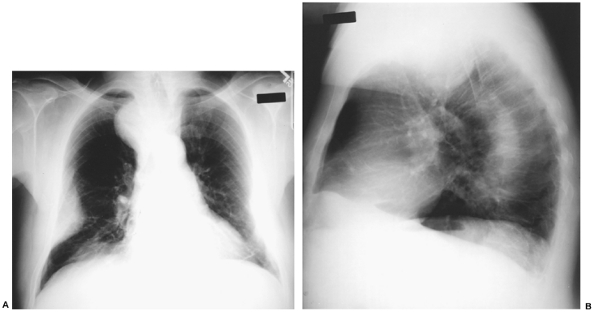 |
Fig. 197-12. A. Posteroanterior radiograph of a patient with severe hyperparathyroidism reveals a right superior mediastinal mass and a chest wall mass caused by a Brown tumor of the rib cage. B. Lateral radiographic view reveals a large mediastinal mass located in the retrotracheal portion of the visceral compartment. From Shields TW, Immerman SC: Mediastinal parathyroid cysts revisited. Ann Thorac Surg 67:581, 1999. With permission. |
Parathyroid cysts may be found in three areas of the mediastinum: (a) the anterosuperior (pretracheal) portion of the visceral compartment, the most common site (57.2%); (b) the paratracheal and retrotracheal area of the visceral compartment from the tracheoesophageal groove to as far posterior as the vertebral column (28.1%) (Figs. 197-12 and 197-13); and (c) the true anterior or prevascular compartment, as an intrathymic cyst or outside but adjacent to the thymic gland, the least common site (14.5%). Many of the anterosuperior lesions extend into the base, or extend from
P.2861
the base, of the neck and may be discovered as a palpable neck mass that may move on swallowing. These are often referred to as cervicomediastinal cysts. The retrotracheal cysts are generally only identified on radiographic examination. Extension of the cyst from one of the aforementioned areas into the other adjacent one is not uncommon. The lesions in the anterior compartment are most often identified on mediastinal exploration in patients with persistent hyperparathyroidism after an unsuccessful neck exploration, although rarely the cyst may arise in the neck and extend into the anterior compartment in front of the innominate vein. In this situation, compression or thrombosis of the innominate vein may occur, as observed by Darras and associates (1992). Facial edema also may occur, as noted by Ito and colleagues (1999).
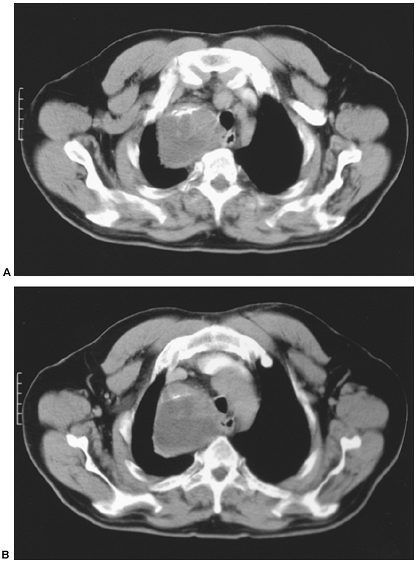 |
Fig. 197-13. A, B. CT views of the large right-sided mass in the retrotracheal portion of the visceral compartment of the mediastinum. Note calcification in the wall of the mass. On excision, the lesion proved to be a parathyroid cyst. Clinically, the cyst was functioning, resulting in severe hyperparathyroidism. From Shields TW, Immerman SC: Mediastinal parathyroid cysts revisited. Ann Thorac Surg 67:581, 1999. With permission. |
The origins of these cysts are debated. Most are associated with a lower parathyroid gland (parathyroid III) or possibly from residual K rsteiner (1899) canalicular rudiments, as suggested by Gilmour (1939). However, some are definitely associated with a superior parathyroid gland (parathyroid IV). This has been documented by Cruse and Daouk (1978), Rosenberg (1982), Calandra (1983), Kinoshita (1986), and Guvendick (1993) and their colleagues. A few have been associated with a fifth supernumerary parathyroid gland. Specifically, most parathyroid cysts that are located or extend into the anterosuperior space are associated with or arise from an inferior parathyroid gland (embryologic parathyroid III). Very infrequently a superior gland (embryologic parathyroid IV) or a sumernumerary fifth gland is the source. Conversely, cysts in the para- or retrotracheal area of the visceral compartment are from an original superior gland (parathyroid IV) in at least 20% of the cases. The displaced superior parathyroid gland (cyst) migrates laterally into the retrotracheal prevertebral space. The displaced gland is in the same plane or even behind the esophagus as it descends into the mediastinum (see Chapter 156). Frequently in this situation, a vascular pedicle passes from the cyst up into the neck, as noted by myself and Immerman (1999). However, an inferior gland may be the source, as noted by Gurbuz and Peetz (1996) as well as by Gough (1999). The cysts in the anterior compartment are associated with either an inferior gland or on frequent occasions with a fifth supernumerary gland, as noted by Bondeson and Thompson (1991) and Downey and associates (1995). The actual mechanism of development is unknown, but in most cases it is thought to be by a process of cystic degeneration, as suggested by Rogers and colleagues (1969) as well as many other investigators.
A mediastinal parathyroid cyst may be asymptomatic, but more often it is symptomatic. A neck mass may be palpable, sometimes referred to as a cervicomediastinal cyst. A large pre- or paratracheal cyst, as recently reported by Braccini and associates (2000), may cause dyspnea as the result of tracheal deviation or narrowing. Dysphagia may be caused by esophageal compression. Hoarseness caused by paresis of one of the vocal cords as the result of pressure or tension on the ipsilateral recurrent laryngeal nerve has been reported by Crile and Perryman (1953), Beahrs and Devine (1961), and Marco (1983), Takahashi (1988), Delaunay (1990), Coates (1991), and Landau (1997) and their associates, as well as others. An overall incidence of 8.7% (9 of 103) was noted in the aforementioned review. Innominate vein compression or thrombosis has been recorded by Darras (1992), Thomas de Montpr ville (1993), and Ito (1999) and their colleagues.
Functioning Parathyroid Cysts
Of more interest is that slightly more than 40% of the cysts recorded in the literature have been associated with documented hyperparathyroidism, the so-called functioning cysts, with varying clinical findings from being asymptomatic to presenting with an acute hypercalcemic crisis, as reported by Calandra (1983) and Linos (1989) and their colleagues, as well as by Gurbuz and Peetz (1996). In one
P.2862
patient reported by Kinoshita and associates (1986), a functioning parathyroid cyst was associated with a multiple endocrine neoplasia type I syndrome.
The mechanism of the resultant hyperparathyroidism in some patients and not in others is unknown. The process by which the high PTH levels that are noted in the cystic fluid of these patients with functioning cysts gains access to the general circulation and thus affects the level of the serum PTH to result in hyperparathyroidism has yet to be answered.
Diagnosis and Treatment
A preoperative diagnosis was rarely made until the late 1970s and the 1980s. The development of ultrasonography, CT scans, and magnetic resonance (MR) imaging to establish the cystic nature of the lesion is most important to the subsequent needle aspiration of clear, colorless fluid, which strongly suggests the diagnosis. The diagnosis is confirmed by the determination of the presence of PTH in the cystic fluid that is at a higher level than that in the serum, as reported by Ginsberg (1978), Pacini (1985), and Silverman (1986) and their colleagues. This is true of the nonfunctioning as well as the functioning cysts. The mechanism by which some cysts are associated with hyperparathyroidism is unclear, although many of the functioning cysts contain a macroscopic mass of parathyroid tissue and often are of the cystic adenomatous variety. The PTH levels in these functioning cysts tend to be much higher than that in the simple nonfunctioning cysts.
Treatment is surgical excision. The first documented surgical removal of a parathyroid cyst from the mediastinum was reported by de Quervain at the Chirugischen Klinik des Inspelspitals in Bern, Switzerland, in 1925. This was performed via a cervical collar incision. Most of these cysts have been removed surgically through a collar cervical incision since that time, less often by a standard thoracotomy or a median sternotomy. Hirano (1997b), Shimizu (1997), Shibata (1998), and Oyama (1999) and their associates have treated these cysts by thoracoscopy. Surgical mortality has been absent and the morbidity rates are low. Only two patients with mediastinal cysts have been treated by fine-needle aspiration alone, one patient reported by Krudy and colleagues (1984) and another patient by Spitz (1995). Although apparently successful, this course of management is not recommended in the vast majority of patients with this lesion. When aspiration of a small nonfunctioning cyst is performed, Okamura and associates (1992) recommended that sclerotherapy with tetracycline be used after aspiration of the cyst.
THORACIC DUCT CYST
Another extremely rare mediastinal cyst is the thoracic duct cyst. Emerson's 1950 review cites Cabone with the discovery of this pathologic entity in 1892. A cyst of the thoracic duct was noted at autopsy at the levels of the tenth and eleventh thoracic vertebrae. A few of the first examples of diagnosis of thymic duct cysts during life were by Bakst (1954) and Thomas (1963), Fromang (1975), and Luosto (1978) and their colleagues. In a review of thoracic duct cysts by Tsuchiya and associates (1980), a total of eight surgically treated cases were described. Yokochi and colleagues (1994) noted that at least 25 cases of thoracic duct cysts had been reported in the literature up to that time. Additional case reports, such as that by Muro and co-workers (1996), have been published since that date. The cysts were located in either the costovertebral sulcus or the visceral compartment of the mediastinum.
Two varieties of thoracic duct cysts are described: degenerative and lymphangiomatous. Ross (1961) and Kausel and associates (1957) noted that degenerative cysts are usually only incidental autopsy findings in elderly patients. Fibrosis, atherosclerotic plaques, and areas of calcification are seen in the cyst wall.
The lymphangiomatous cysts occur in younger individuals in their fourth or fifth decades of life. Gowar (1978) postulated that a thoracic duct cyst occurs secondary to a congenital weakness of the wall, resulting in aneurysmal dilatation and subsequent cyst formation. Communication with the thoracic duct is universally associated with the lesion. Pathologically, the cysts are described as unilocular with an associated connection to the thoracic duct. The cyst is lined with only occasional endothelial cells and contains chylouslike fluid.
Radiographically, thoracic duct cysts appear as a round or oval, sharply circumscribed mass in the visceral compartment that may extend into the ipsilateral paravertebral sulcus (Fig. 197-14). These cysts may occur anywhere along the course of the duct within the mediastinum. The cystic nature of the lesion may be determined by CT examination, but this does not differentiate it from any other mediastinal cystic lesion. Of the eight surgically treated patients described by Tsuchiya and colleagues (1980), only one was diagnosed preoperatively by a lymphangiogram. Hori and associates (1980) also reported the preoperative diagnosis by a lymphangiogram. Morettin and Allen (1986) reported the preoperative diagnosis by needle aspiration of chyle from a suspected cystic structure.
Thoracic duct cysts as opposed to other mediastinal cysts are responsible for a high incidence of symptoms. In the review of Tsuchiya and associates (1980), six of the eight patients were symptomatic as the result of pressure on adjacent structures, most commonly the trachea or esophagus. Symptoms of dysphagia were often associated with ingestion of fatty foods. Cervantes-Perez and Fuentes-Maldonado (1976) and Fromang and colleagues (1975) also noted the occurrence of acute respiratory insufficiency after ingestion of a fatty meal in some patients with thoracic duct cysts. Removal may be accomplished via a thoracotomy, as reported by Yokochi and colleagues (1994), as well as by others, or may be removed via a VATS approach, as recorded by Muro and associates (1996).
 |
Fig. 197-14. Right lateral (A) and posteroanterior (B) radiographic views of the chest show a large ovoid mass (arrows) in the superior portion of the visceral compartment of the mediastinum with displacement of the trachea anteriorly and extension of the mass posteriorly into the paravertebral sulcus. On excision, the mass proved to be a thoracic duct cyst. From Ochsner JL, Ochsner SF: Congenital cysts of the mediastinum: 20-year experience with 42 cases. Ann Surg 163:909, 1966. With permission. |
P.2863
Because these lesions are most often symptomatic, all require surgical excision. As expected, postoperative chylothorax is the major postoperative complication. To prevent this complication, with any lesion suspected of being a thoracic duct cyst at operation, special care should be taken to identify and ligate the consistently present communication with the thoracic duct.
HYDATID CYSTS
Primary mediastinal cysts caused by the larval stage of E. granulosus are rare. In an extensive review by Rakower and Milwidsky (1960), who recorded more than 23,000 patients with hydatid disease in various large series, only 25 cases (0.1%) of the echinococcal cysts were reported to have occurred primarily within one of the mediastinal compartments or paravertebral sulci. Nin Vivo and associates (1989) recorded an incidence of 0.38% of primary mediastinal echinococcal cysts in all patients with thoracic tumors undergoing surgery at their hospital in Montevideo, Uruguay, which is well-known as an endemic area for the disease. However, neither Peschiera (1972) nor Aletras and Symbas (1989) recorded either a primary or secondary mediastinal hydatid cyst in their respective chapters in the first and third editions of General Thoracic Surgery. Also, Qian (1988) from China recorded no primary cysts in this location in 842 cases of thoracic hydatid cysts.
Nonetheless, approximately 100 cases of primary mediastinal echinococcal cysts have been recorded in the literature. Trigo and colleagues (1959) and Rakower and Milwidsky (1960) collected the 74 cases reported in the literature up to the time of their reports. The latter investigators added six of their own cases, and Nin Vivo and associates (1989) reported seven additional cases. Also, a few isolated cases were recorded between 1960 and 1990 in the South American, European, and North American literature.
Rakower and Milwidsky (1960) reported that more than 55% of the primary cysts occur in either paravertebral sulcus (Fig. 197-15). Cysts located here may expand the adjacent intercostal spaces, erode through the chest wall, or migrate into the spinal canal via an adjacent intervertebral foramen. An especially interesting variety is the so-called pince-nez cyst, which involves both paravertebral sulci and passes anterior to the vertebral body behind the aorta and esophagus (Fig. 197-16). Less than 8% of the primary mediastinal echinococcal cysts are recorded to occur in the visceral compartment. Here, however, they may result in compression of the airway or the superior vena cava and have been reported to have eroded into the pericardium. Marti-Bonmati and colleagues (1988) reported one case in which the cyst ruptured into the aorta. The remaining 36% are said to occur in the anterior compartment, especially in the region of the thymus; however, some of these in the more superior portion of the thorax actually may have been located in the superior portion of the visceral compartment. Extension of the cyst into the neck may occur.
Secondary echinococcal cysts in the mediastinum occur more commonly than do the primary ones. These secondary cysts are the result of a rupture of a paramediastinal hydatid cyst, penetration of a subdiaphragmatic cyst through the
P.2864
diaphragm, or migration of one or more hydatid cysts into the visceral compartment via the esophageal hiatus (Fig. 197-17). This migration usually only occurs in patients with extensive intraabdominal disease. King and Smith (1989) noted such a patient, and I have treated a similar patient; both patients were immigrants from endemic areas of the disease in Europe. The actual incidence of such secondary mediastinal hydatid cysts, however, remains unknown.
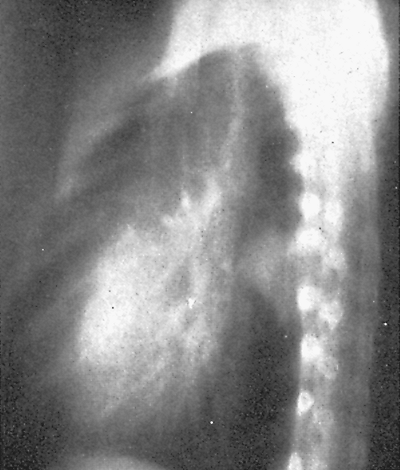 |
Fig. 197-15. Lateral radiograph reveals paravertebral mass that proved to be a primary mediastinal hydatid cyst. From Rakower J, Milwidsky H: Primary mediastinal echinococcosis. Am J Med 29:73, 1960. With permission. |
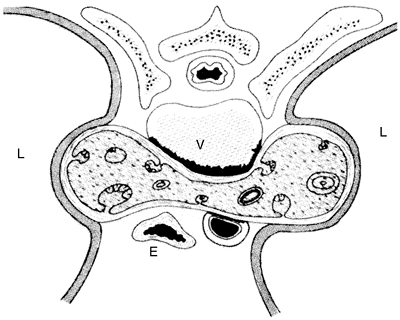 |
Fig. 197-16. Schematic illustration of a pince-nez hydatid cyst of the mediastinum. E, esophagus; L, lung; V, vertebral body. From Rakower J, Milwidsky H: Primary mediastinal echinococcosis. Am J Med 29:73, 1960. With permission. |
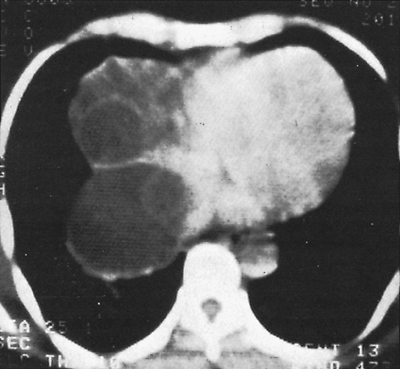 |
Fig. 197-17. CT scan of the chest shows multiple juxtamediastinal hydatid cysts originating in the subdiaphragmatic space. From Nin Vivo J, Brandolino MV, Pomi J: Hydatid cysts of the mediastinum. In Martini N, Vogt-Moykopf I (eds): Thoracic Surgery: Frontiers and Uncommon Neoplasms. St. Louis: CV Mosby, 1989. With permission. |
The echinococcal cysts may be discovered at any age and appear to be more common in men than in women. The patient is invariably living in or from an area where the disease is endemic.
On radiographic examination, the cyst is usually a smoothly rounded area of increased density. Occasionally, a thin rim of eggshell calcification may be present, but this is less common here than it is in cysts of the liver or spleen. The radiographic signs described for echinococcal cysts of the lung are rarely present unless the cyst has eroded into the tracheobronchial tree and the erosion has permitted air to enter the cyst. CT may be helpful in discerning the cystic nature of the lesion, in localizing possible daughter cysts, and in following the results of the lesion's treatment.
In patients suspected of having the disease, the Weinberg complement fixation test or the indirect hemagglutination test may be helpful. These and other laboratory studies are briefly discussed by Symbas in Chapter 91. Nin Vivo and associates (1989) suggest that immunoelectrophoresis is usually specific, especially the double diffusion band test.
Treatment is surgical excision through the appropriate thoracic incision. Care must be taken to avoid rupture of the cyst during its removal. The pericystic membrane may be left behind. Le Roux and colleagues (1984) noted that the cyst usually can be enucleated whole from within this adventitious capsule. The various techniques of removal of the cyst intact, with or without intraoperative needle aspiration, are discussed by Aletras and Symbas (1989). In those patients in whom surgical excision is believed to be too hazardous because of involvement of vital structures, medical therapy with mebendazole or albendazole may be attempted (Fig. 197-18). Oppermann and associates (1982) reported successful treatment using mebendazole of a large cyst located in the anterior compartment in a child. Complete resolution occurred as determined by sequential postchemotherapy CT examinations.
MEDIASTINAL CYSTS ARISING FROM NECROTIC LYMPH NODES
Rasmussen and Madsen (1990) have described the development of mediastinal cysts from extensive necrosis of enlarged lymph nodes. Schwarz and associates (1976) had described similar cystic structures resulting from necrosis of enlarged lymph nodes involved by histoplasmosis. Either type may become quite large, and they are located in the visceral compartment. Residual lymphatic tissue may be present at the periphery of these cystic structures. Petkar and associates (2001) recorded two patients with a cyst located in the anterior compartment of the mediastinum due to necrosis of an enlarged lymph node as the end result of Mycobacterium tuberculosis infection of the gland. Each cyst revealed a thick, fibrotic, gray-white wall that contained multiple caseating tuberculous granulomas with a
P.2865
few identifiable lymphoid follicles. Treatment after excision is a standard antituberculosis chemotherapy regimen.
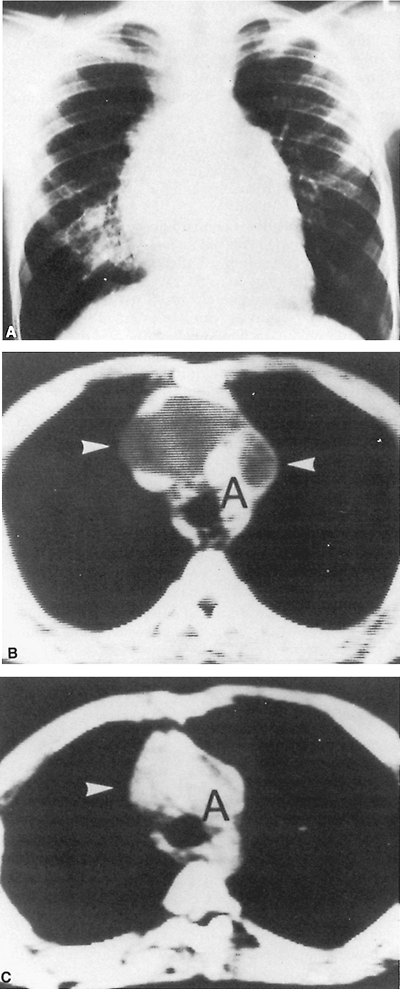 |
Fig. 197-18. A. Large anterior mediastinal mass seen on posteroanterior radiograph of the chest. B. CT scan of the chest revealed multiple cysts in the anterior mediastinal compartment that were proved to be caused by echinococcosis on appropriate diagnostic studies. A, aorta; cysts marked by arrows. C. CT scan shows marked resolution of the cystic lesions after therapy with mebendazole. A, aorta; cyst marked by arrow. From Opperman HC, et al: Mediastinal hydatid disease in childhood: CT documentation of response to treatment with mebendazole. J Comput Assist Tomogr 6:175, 1982. With permission. |
REFERENCES
Abell MR: Mediastinal cysts. Arch Pathol 61:360, 1956.
Akashi A, et al: The results and prognosis of surgical treatment for primary mediastinal tumors in children. J Jpn Assoc Chest Surg 9:135, 1995.
Aletras H, Symbas PN: Hydatid disease of the lung. In Shields TW (ed): General Thoracic Surgery. 3rd Ed. Philadelphia: Lea & Febiger, 1989.
Allee G, Logue B, Mansour K: Thymic cyst simulating multiple cardiovascular abnormalities and presenting with pericarditis and pericardial tamponade. Am J Cardiol 31:377, 1973.
Avila NA, et al: Multilocular thymic cysts: imaging features in children with human immunodeficiency virus infection. Radiology 201:130, 1996.
Babu MK, Nirmala V: Thymic carcinoma with glandular differentiation arising in a congenital thymic cyst. J Surg Oncol 57:277, 1994.
Bakst AA: Blind supradiaphragmatic thoracic duct cyst. Case report. Ann Surg 140:250, 1954.
Beahrs OH, Devine KD: Unusual diagnostic problems in the neck. Surg Clin North Am 41:1069, 1961.
Bieger CR, McAdams AJ: Thymic cysts. Arch Pathol 82:535, 1966.
Bondeson A-G, Thompson NW: Mediastinal parathyroid adenomas and carcinomas. In Shields TW (ed): Mediastinal Surgery. Philadelphia: Lea & Febiger, 1991, p. 289.
Borges AC, et al: Acute right-sided heart failure due to hemorrhage into a pericardial cyst. Ann Thorac Surg 63:845, 1997.
Braccini F, et al: Essential parathyroid cysts: a misleading lesion. [Le kyste parathyro dien essential: una affection trompeuse.] Rev Laryngol Otol Rhinol (Bord) 121:165, 2000.
Calandra DB, et al: Parathyroid cysts: a report of eleven cases including two associated with hyperparathyroid crisis. Surgery 94:887, 1983.
Cervantes-Perez P, Fuentes Maldonado R: Thoracic duct cyst of the mediastinum [Letter]. Chest 70:411, 1976.
Childress ME, Baker CP, Sampson PC: Lymphangioma of the mediastinum. J Thorac Surg 31:338, 1956.
Choi YW, et al: Idiopathic multilocular thymic cyst: CT features with clinical and histopathologic correlation. AJR 177:881, 2001.
Chopra PS, et al: Pericardial cyst with partial erosion of the right ventricular wall. Ann Thorac Surg 51:840, 1991.
Coates G, Pearman K, Holl-Allen RTJ: Recurrent nerve palsy due to parathyroid cyst. Int Surg 76:192, 1991.
Cohen AJ, et al: Primary cysts and tumors of the mediastinum. Ann Thorac Surg 51:378, 1991.
Crile G Jr, Perryman RG: Parathyroid cysts. Report of five cases. Surgery 14:151, 1953.
Cruse CW, Daouk AA: Mediastinal parathyroid cyst. Report of a case and review of the literature. Am J Surg 135:714, 1978.
Darras T, et al: Acutely symptomatic benign mediastinal cysts. J Belge Radiol 75:111, 1992.
Delaunay T, et al: Les kystes des parathyro des: propos de six cas. Ann Chir 44:231, 1990.
de Quervain F: Epithelial-K rperchen-Cysti. Schweiz Med Wochenschr 55:1169, 1925.
Downey RJ, et al: Mediastinal parathyroid cysts. Mayo Clin Proc 70:946, 1995.
Dubois P: Du diagnostic de la syphilis congenitale. Gaz Med Par 21:392, 1850.
Emerson GL: Supradiaphragmatic thoracic duct cyst. An unusual mediastinal tumor. N Engl J Med 242:575, 1950.
Fahmy S: Cervical thymic cysts: their pathogenesis and relationship to brachial cysts. J Laryngol Otol 88:47, 1974.
Fraile G, et al: Thymic cyst presented as Horner's syndrome. Chest 101:1170, 1992.
Fromang DR, Seltzer MR, Tobias JA: Thoracic duct cyst causing mediastinal compression and acute respiratory insufficiency. Chest 67:725, 1975.
Gilmour JR: The normal histology of the parathyroid glands. J Pathol Bacteriol 48:187, 1939.
Ginsberg J, Young JE, Walfish PG: Parathyroid cysts. Medical diagnosis and management. JAMA 204:1506, 1978.
P.2866
G n l U, et al: Huge thymic cysts. J Thorac Cardiovasc Surg 112:835, 1996.
Gough JR: Parathyroid cysts. Aust N Z J Surg 69:404, 1999.
Gouliamos A, et al: Thymic cyst. J Comput Assist Tomogr 6:172, 1982.
Gowar FJ: Mediastinal thoracic duct cyst. Thorax 33:800, 1978.
Graeber GM, et al: Cystic lesion of the thymus: an occasionally malignant cervical and/or anterior mediastinal mass. J Thorac Cardiovasc Surg 87:295, 1984.
Guba AM Jr, et al: Cervical presentation of thymic cysts. Am J Surg 136:430, 1978.
Gurbuz AT, Peetz ME: Giant mediastinal parathyroid cyst: an unusual cause of hypercalcemic crisis case report and review of the literature. Surgery 120:795, 1996.
Guvendick L, et al: Management of a mediastinal cyst causing hyperparathyroidism and tracheal obstruction. Ann Thorac Surg 55:167, 1993.
Hendrickson M, et al: Congenital thymic cysts in children mostly misdiagnosed. J Pediatr Surg 33:821, 1998.
Hirano S, et al: Cystic mediastinal tumor: a clinical study. J Jpn Assoc Chest Surg 11:13, 1997a.
Hirano S, et al: Two patients with mediastinal parathyroid cysts. Nippon Kyobu Shikkan Gakkai Zasshi 35:82, 1997b.
Hori S, et al: Lymphangiographic demonstration of thoracic duct cyst. Chest 78:652, 1980.
Ito Y, et al: Two cases of mediastinal parathyroid cyst. J Jpn Assoc Chest Surg 13:77, 1999.
Jamplis RW, Lillington GA, Mills W: Pleural cysts simulating mediastinal tumors. JAMA 185:727, 1963.
Jaramillo D, Perez-Atayade A, Griscom NT: Apparent association between thymic cysts and prior thoracotomy. Radiology 172:207, 1989.
Jost RG, et al: Computed tomography of the thorax. Radiology 126:125, 1978.
Kaimal KP: Computed tomography in the diagnoses of pericardial cyst. Am Heart J 103:566, 1982.
Kausel HW, et al: Anatomic and pathologic studies of the thoracic duct. J Thorac Cardiovasc Surg 34:631, 1957.
Kinoshita Y, et al: A case of multiple endocrine neoplasia type I with growth hormone and prolactin secreting pituitary adenoma, functioning large parathyroid cyst and Zollinger-Ellison syndrome. Nippon Naika Gakkai Zasshi (J Jpn Soc Intern Med) 75:512, 1986.
King TC, Smith CR: Chest wall, pleura, lung and mediastinum. In Schwartz ST, Shires GT, Spencer FC (eds): Principles of Surgery. 5th Ed. New York: McGraw-Hill, 1989.
Klein DL: Pleural cyst of the mediastinum. Br J Radiol 51:548, 1978.
Kondo K, et al: Multilocular thymic cyst associated with Sj gren's syndrome. Ann Thorac Surg 72:1367, 2001.
Kornstein MJ: Pathology of the Thymus and Mediastinum. Philadelphia: WB Saunders, 1995, p. 58.
Krech WG, Storey CF: Thymic cysts. J Thorac Surg 27:477, 1954.
Krudy AG, et al: Hyperfunctioning cystic parathyroid glands: CT and sonographic findings. AJR 142:175, 1984.
Kurihara H, et al: Thymic cyst with malignant thymoma: a case report. J Jpn Assoc Chest Surg 9:48, 1995.
Kuriyama K, et al: Functioning parathyroid cyst extending from neck to anterior mediastinum. Diagnosis by sonography and computed tomography. Diagn Imag Clin Med 55:301, 1986.
K rsteiner W: Die epithalkorperchen des herschen in iher bezichung zur thyroides und thymus. Anat Hafte 11:391, 1899.
Kutlay H, et al: Atypically located pericardial cysts. Ann Thorac Surg 72:2137, 2001.
Lambert AVS: Etiology of thin-walled thoracic cysts. J Thorac Surg 10:1, 1940.
Landau O, et al: Mediastinal parathyroid cysts. Ann Thorac Surg 63:951, 1997.
Leong AS, Brown JH: Malignant transformation in a thymic cyst. Am J Surg Pathol 8:471, 1984.
le Roux BT: Pericardial coelomic cysts. Thorax 14:27, 1959.
le Roux BT, Kallichurum S, Shama DM: Mediastinal cysts and tumors. Curr Probl Surg 21:1, 1984.
Lillie WI, McDonald JR, Clagett OT: Pericardial celomic cysts and pericardial diverticula. J Thorac Surg 20:494, 1950.
Linos DA, Schoretsanitis G, Carvounis E: Parathyroid cysts of the neck and mediastinum: case report. Acta Chir Scand 155:211, 1989.
Luosto R, et al: Thoracic duct cyst of the mediastinum. A case report. Scand J Thorac Cardiovasc Surg 12:261, 1978.
Marco V, et al: Cytomorphology of a mediastinal parathyroid cyst. Report of a case mimicking malignancy. Acta Cytol 27:688, 1983.
Margolis IB, Wayne R, Organ CH Jr: Parathyroid cysts: functional and mediastinal. Surgery 77:462, 1975.
Marti-Bonmati L, Touza R, Montes H: CT diagnosis of primary mediastinal hydatid cyst rupture into the aorta: a case report. Cardiovasc Intervent Radiol 11:296, 1988.
Mastroroberto P, et al: Pericardial cyst with partial erosion of the superior vena cava. An unusual case. J Cardiovasc Surg (Torino) 37:323, 1996.
Miller JS, et al: Intermittent brachiocephalic vein obstruction secondary to a thymic cyst. Ann Thorac Surg 70:662, 2000.
Molinari AS, et al: Incidence of multiglandular disease in primary hyperparathyroidism determined by parathyroid hormone secretion. Surgery 120:936, 1996.
Monnier G, et al: Un nouveau cas de kyste thymique paracardiaque. [A new case of pericardial thymic cyst.] Arch Mal Coeur Vaiss 93:875, 2000.
Morettin LB, Allen TE: Thoracic duct cyst: diagnosis with needle aspiration. Radiology 161:437, 1986.
Muro M, et al: Video-assisted thoracoscopic surgery for a mediastinal thoracic duct cyst: a case report. J Jpn Assoc Chest Surg 10:789, 1996.
Nathaniels EK, Nathaniels AM, Wang CA: Mediastinal parathyroid tumors: a clinical and pathological study of 84 cases. Ann Surg 171:165, 1970.
Nin Vivo J, Brandolina MV, Pomi J: Hydatid cysts of the mediastinum. In Delarue NC, Eschapasse H (eds): International Trends in General Thoracic Surgery. Vol. 5. Thoracic Surgery: Frontiers and Uncommon Neoplasms. St. Louis: CV Mosby, 1989.
Noble JF, Borg JF: Hyperparathyroidism complicated by hyperthyroidism. Report of a case. Arch Intern Med 58:846, 1936.
Noriyuki T, et al: Thymoma in a residual thymic cyst: a case report. J Jpn Assoc Chest Surg 9:35, 1995.
Ochsner JL, Ochsner SF: Congenital cysts of the mediastinum. 20 year experience with 42 cases. Ann Surg 163:909, 1966.
Okamura K, et al: Sclerotherapy for benign parathyroid cysts. Am J Surg 163:344, 1992.
Oppermann HC, et al: Mediastinal hydatid disease in childhood: CT documentation of response to treatment with mebendazole. J Comput Assist Tomogr 6:175, 1982.
Oyama T, et al: Mediastinal parathyroid cyst: treatment with thoracoscopic surgery a case report. J UOEH 21:317, 1999.
Pacini F, et al: Unsuspected parathyroid cysts diagnosed by measurement of thyroglobulin and parathyroid hormone concentrations in fluid aspirates. Ann Intern Med 102:793, 1985.
Peschiera CA: Hydatid disease of the lung. In Shields TW (ed): General Thoracic Surgery. 1st Ed. Philadelphia: Lea & Febiger, 1972.
Petkar M, Vaideeswar P, Deshpande JR: Surgical pathology of cystic lesions of the mediastinum. J Postgrad Med 47:235, 2001.
Pickhardt QC: Pleurodiaphragmatic cyst. Ann Surg 99:814, 1934.
Pugatch RD, et al: CT diagnosis of pericardial cysts. AJR 131:515, 1978.
Qian ZX: Thoracic hydatid cysts: a report of 842 cases treated over a thirty year period. Ann Thorac Surg 46:342, 1988.
Rakower J, Milwidsky H: Primary mediastinal echinococcosis. Am J Med 29:73, 1960.
Rasmussen LD, Madsen KM: Tuberculous cysts of the mediastinum. Radiologe 30:299, 1990.
Rastegar H, Arger P, Harken AH: Evaluation and therapy of mediastinal thymic cyst. Am Surg 46:237, 1980.
Rogers LA, Fetter BF, Peete WP: Parathyroid cyst and cystic degeneration of parathyroid adenoma. Arch Pathol 88:476, 1969.
Rosenberg J, et al: Parathyroid cysts. Am J Surg 143:473, 1982.
Ross JK: A review of the surgery of the thoracic duct. Thorax 16:12, 1961.
Satur CM, Hsin MK, Dussek JE: Giant pericardial cysts. Ann Thorac Surg 61:208, 1996.
Schwarz J, Schaen MD, Picardi JL: Complications of the arrested primary histoplasmic complex. JAMA 236:1157, 1976.
Shibata Y, et al: Parathyroid cyst of the mediastinum. J Jpn Assoc Chest Surg 12:676, 1998.
Shields TW, Immerman SC: Mediastinal parathyroid cysts revisited. Ann Thorac Surg 67:581, 1999.
Shields TW, Lees WM, Fox RT: Anterior cardiophrenic angle tumors. Q Bull Northwestern Med Sch 36:363, 1962.
Shimizu M, et al: Thoracoscopic resection of mediastinal parathyroid adenoma with cyst and hyperparathyroidism: a case report. Nippon Kyobu Geka Gakkai Zasshi 45:1972, 1997.
P.2867
Silverman JF, et al: Parathyroid hormone (PTH) assay of parathyroid cysts examined by fine-needle aspiration. Am J Clin Pathol 86:776, 1986.
Simkin EP: Hyperparathyroidism associated with a parathyroid cyst: an unusual presentation. Br J Surg 63:927, 1976.
Soler R, et al: MRI of mediastinal parathyroid cystic adenoma causing hyperparathyroidism. J Comput Assist Tomogr 20:166, 1996.
Spitz AF: Management of a functioning mediastinal parathyroid cyst. J Clin Endocrinol Metab 80:2866, 1995.
Stoller JK, Shaw C, Matthay RA: Enlarging, atypically located pericardial cyst. Chest 89:402, 1986.
Suster S, Rosai J: Multilocular thymic cyst: an acquired reactive process. Study of 18 cases. Am J Surg Pathol 15:388, 1991.
Takahashi E, et al: A case of mediastinal parathyroid cyst. Rinsho Hoshasen (Jpn J Clin Radiol) 33:393, 1988.
Thomas MJ, et al: Thoracic duct cyst of the mediastinum. A case report. Cardiopulm Dis 7:541, 1963.
Thomas de Montpr ville V, Dartevelle P, Dulmet E: Kyste parathyroidien du m diastin ant rier. Ann Pathol (Paris) 13:247, 1993.
Trigo E, Perazzo DL, Carnovali NS: Equinococsis mediastinal. El Torax 8:32, 1959.
Tsuchiya R, et al: Thoracic duct cyst of the mediastinum. J Thorac Cardiovasc Surg 79:856, 1980.
Udaka T, et al: A case of thymic cyst containing thymoma internally and showing elevated levels of CA 19 9 and amylase in the cystic fluid. J Jpn Assoc Chest Surg 9:58, 1995.
Welti H, G rard-Marchant R. propos de cinq novellas observations de kyste parathyroiden. Mem Acad Chir 82:994, 1956.
Wick MR: Mediastinal cysts and intrathoracic thymic tumors. Semin Diagn Pathol 7:285, 1990.
Yamashita S, et al: Thymic carcinoma which developed in a thymic cyst. Intern Med 35:215, 1996.
Yokochi T, et al: Thoracic duct cyst in posterior mediastinum, surrounding thoracic aorta and azygos vein: a case report. J Jpn Assoc Chest Surg 8:624, 1994.
Young R, et al: Cervico-mediastinal thymic cysts. Am J Roentgenol Radium Ther Nucl Med 117:855, 1973.
1Reported by Kutlay H, et al (2001).
EAN: 2147483647
Pages: 203